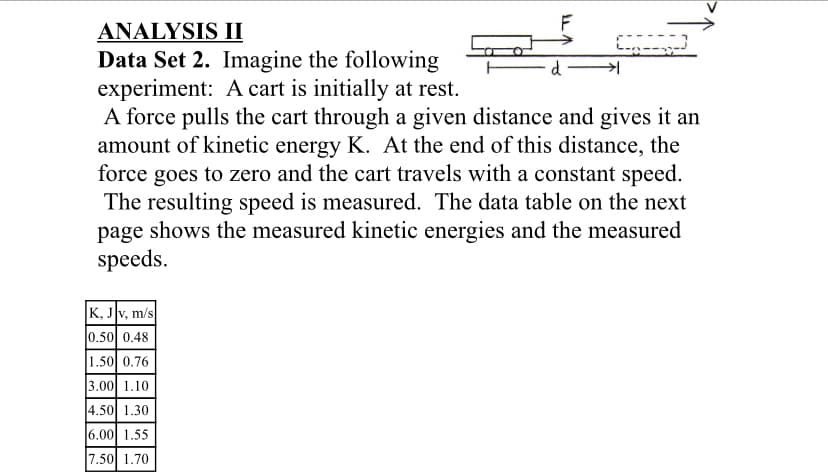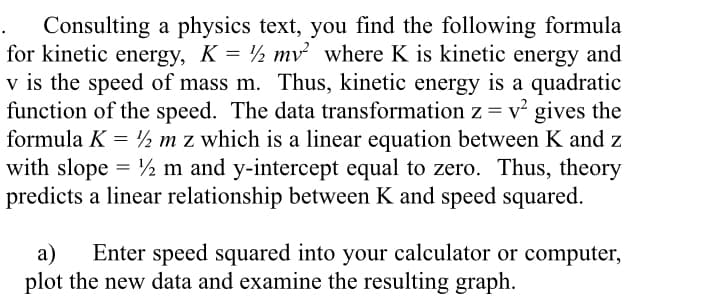ANALYSIS II Data Set 2. Imagine the following experiment: A cart is initially at rest. A force pulls the cart through a given distance and gives it an amount of kinetic energy K. At the end of this distance, the force goes to zero and the cart travels with a constant speed. The resulting speed is measured. The data table on the next page shows the measured kinetic energies and the measured speeds. d K, Jv, m/s 0.50 0.48 1.50 0.76 3.00 1.10 4.50 1.30 6.00 1.55 7.50 1.70
ANALYSIS II Data Set 2. Imagine the following experiment: A cart is initially at rest. A force pulls the cart through a given distance and gives it an amount of kinetic energy K. At the end of this distance, the force goes to zero and the cart travels with a constant speed. The resulting speed is measured. The data table on the next page shows the measured kinetic energies and the measured speeds. d K, Jv, m/s 0.50 0.48 1.50 0.76 3.00 1.10 4.50 1.30 6.00 1.55 7.50 1.70
College Physics
10th Edition
ISBN:9781285737027
Author:Raymond A. Serway, Chris Vuille
Publisher:Raymond A. Serway, Chris Vuille
Chapter6: Momentum And Collisions
Section: Chapter Questions
Problem 7WUE
Related questions
Question

Transcribed Image Text:ANALYSIS II
Data Set 2. Imagine the following
experiment: A cart is initially at rest.
A force pulls the cart through a given distance and gives it an
amount of kinetic energy K. At the end of this distance, the
force goes to zero and the cart travels with a constant speed.
The resulting speed is measured. The data table on the next
page shows the measured kinetic energies and the measured
speeds.
K, Jv, m/s
0.50 0.48
1.50 0.76
3.00 1.10
4.50 1.30
6.00 1.55
7.50 1.70

Transcribed Image Text:Consulting a physics text, you find the following formula
for kinetic energy, K = ½ mv² where K is kinetic energy and
v is the speed of mass m. Thus, kinetic energy is a quadratic
function of the speed. The data transformation z = v gives the
formula K = ½ m z which is a linear equation between K and z
with slope = ½ m and y-intercept equal to zero. Thus, theory
predicts a linear relationship between K and speed squared.
a)
Enter speed squared into your calculator or computer,
plot the new data and examine the resulting graph.
Expert Solution
This question has been solved!
Explore an expertly crafted, step-by-step solution for a thorough understanding of key concepts.
Step by step
Solved in 3 steps with 1 images

Knowledge Booster
Learn more about
Need a deep-dive on the concept behind this application? Look no further. Learn more about this topic, physics and related others by exploring similar questions and additional content below.Recommended textbooks for you

College Physics
Physics
ISBN:
9781285737027
Author:
Raymond A. Serway, Chris Vuille
Publisher:
Cengage Learning

Principles of Physics: A Calculus-Based Text
Physics
ISBN:
9781133104261
Author:
Raymond A. Serway, John W. Jewett
Publisher:
Cengage Learning

University Physics Volume 1
Physics
ISBN:
9781938168277
Author:
William Moebs, Samuel J. Ling, Jeff Sanny
Publisher:
OpenStax - Rice University

College Physics
Physics
ISBN:
9781285737027
Author:
Raymond A. Serway, Chris Vuille
Publisher:
Cengage Learning

Principles of Physics: A Calculus-Based Text
Physics
ISBN:
9781133104261
Author:
Raymond A. Serway, John W. Jewett
Publisher:
Cengage Learning

University Physics Volume 1
Physics
ISBN:
9781938168277
Author:
William Moebs, Samuel J. Ling, Jeff Sanny
Publisher:
OpenStax - Rice University

College Physics
Physics
ISBN:
9781305952300
Author:
Raymond A. Serway, Chris Vuille
Publisher:
Cengage Learning

Physics for Scientists and Engineers: Foundations…
Physics
ISBN:
9781133939146
Author:
Katz, Debora M.
Publisher:
Cengage Learning
